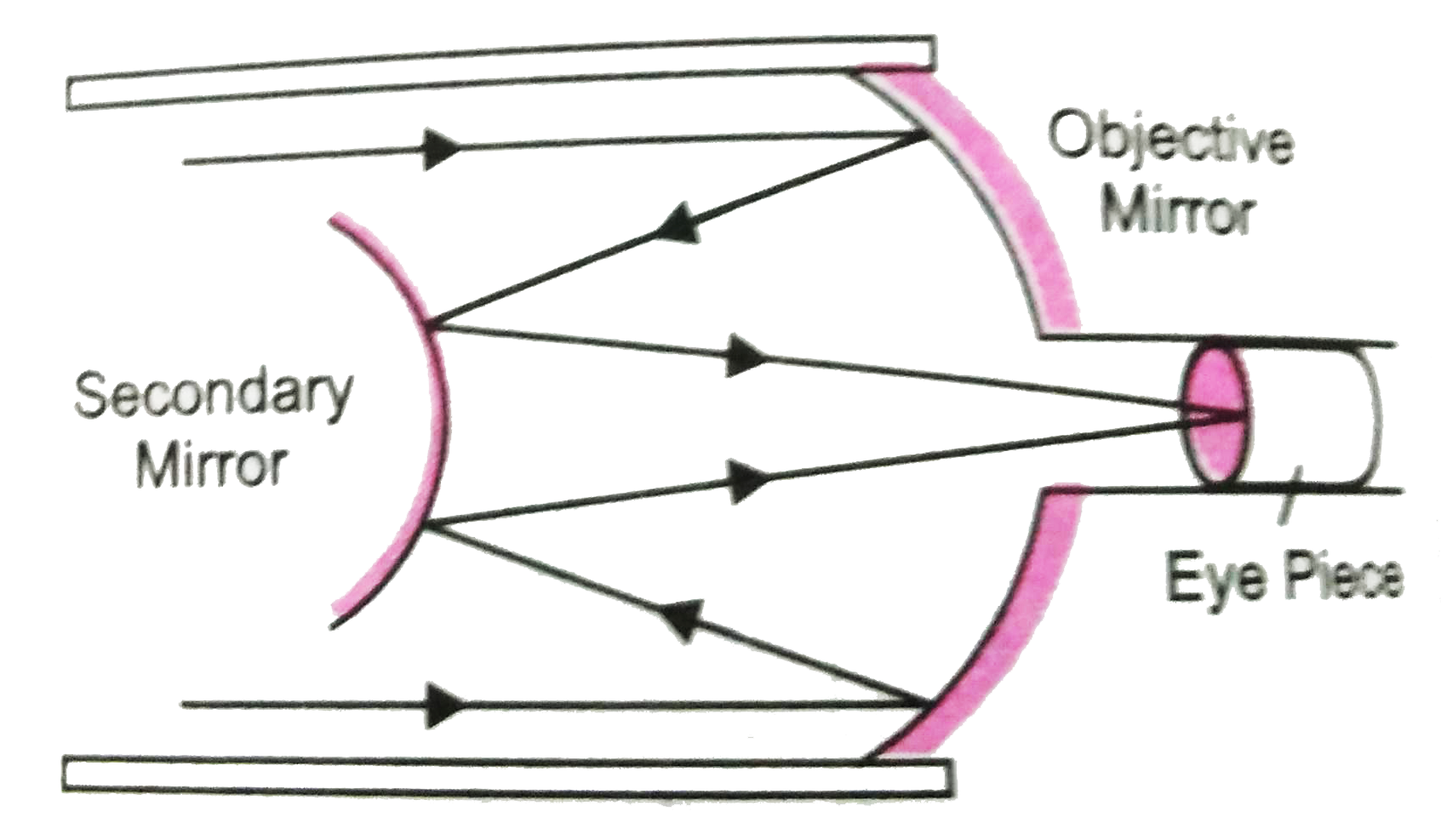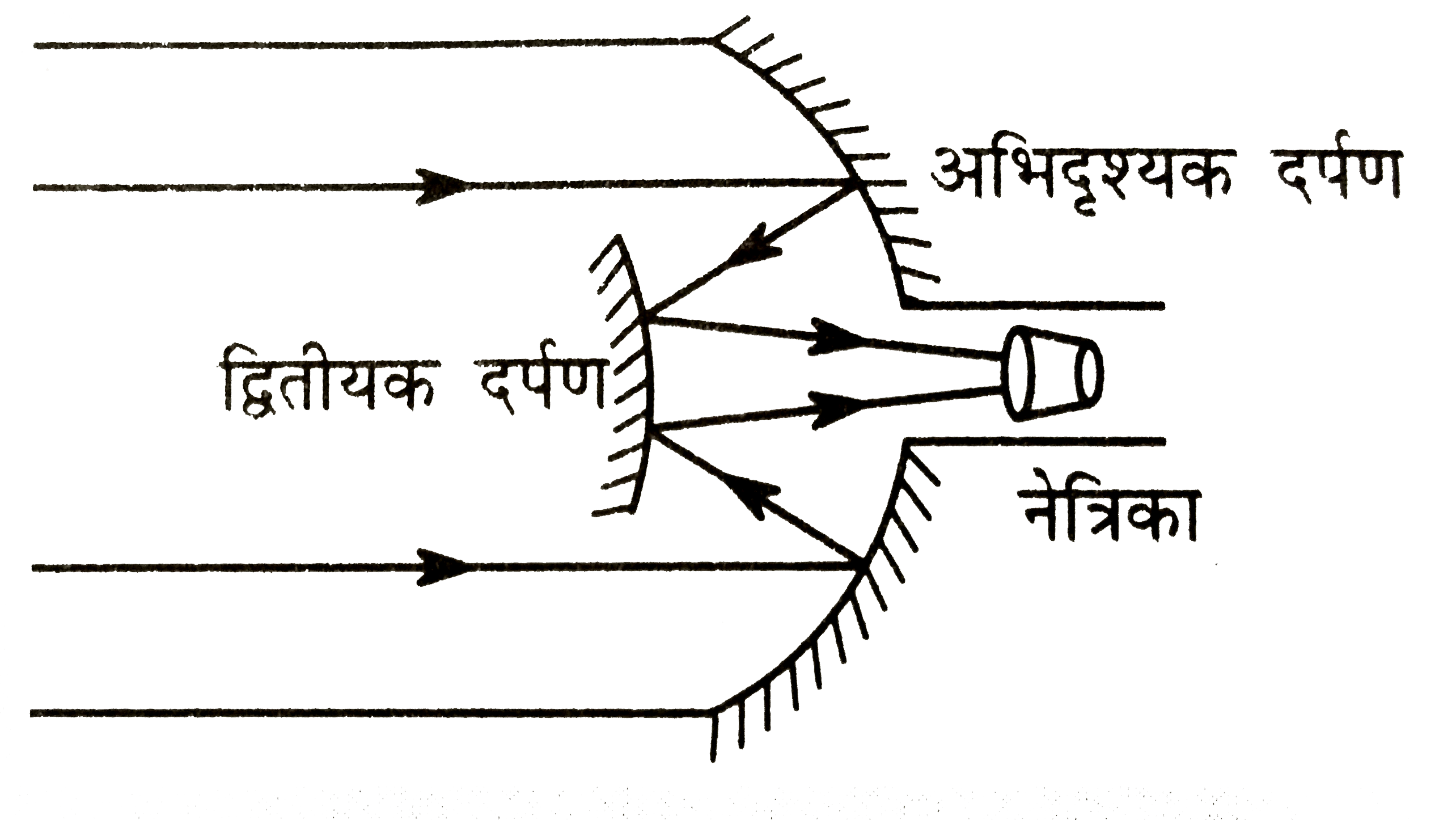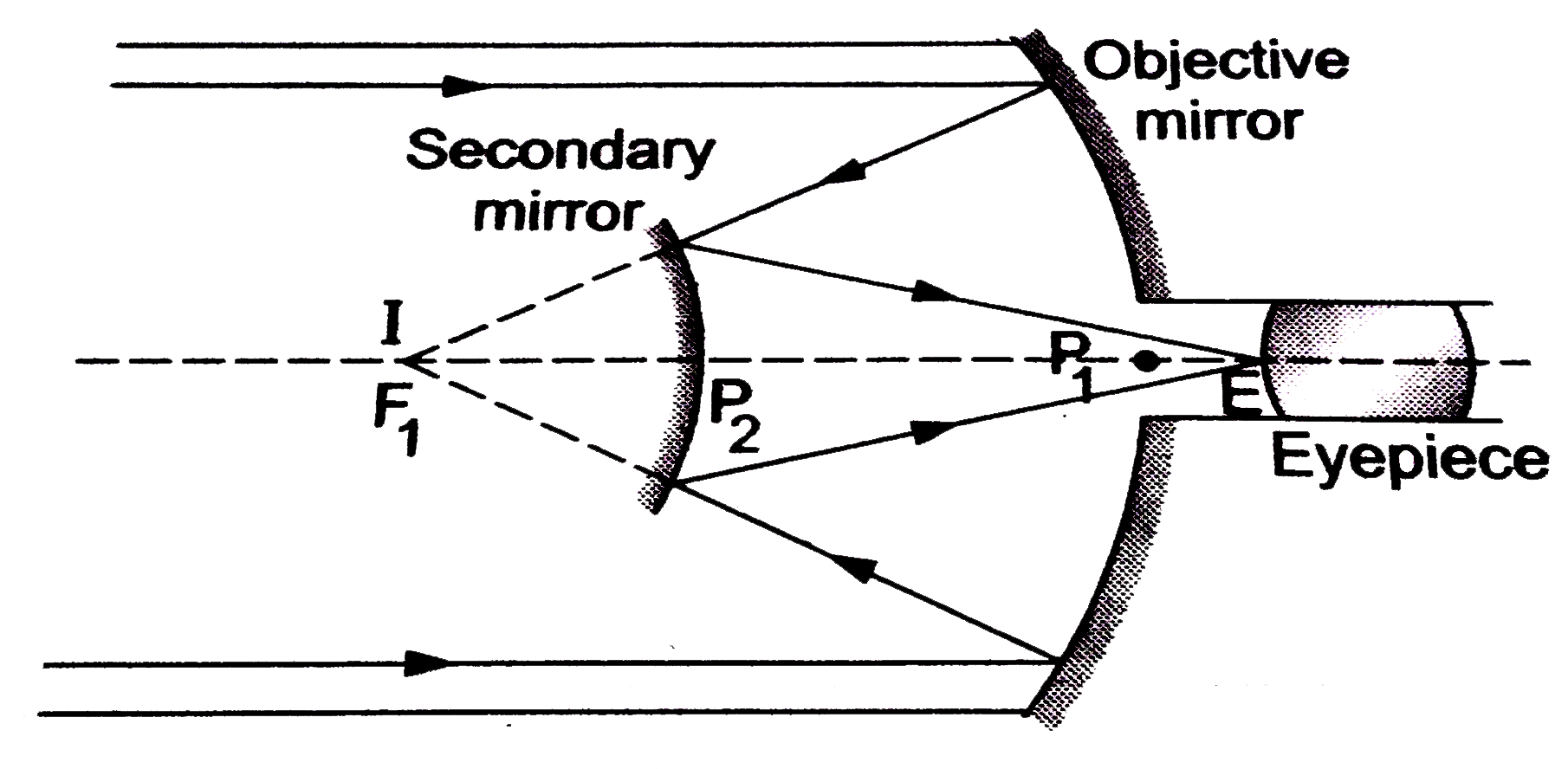A cassegrain telescope is built with the mirrors 20 mm apart. If the radius of curvature of the larger mirror is 220 mm and the small mirror is 140 mm. where will the final image of an object at infinity be ?Solution in Telugu
Here, radius of curvature of objective mirror R1=220mm radius of curvature of secondary mirror R2=140mm,
f2=R22=1402=70mm
Distance between the two mirrors, d = 20 mm. When object is at infinity, parallel rays falling on objective mirror, on reflection, would collect at its focus at
f1=R12=2202=110mm
Instead, they fall on secondary mirror at 20 mm from objective mirror.
∴ For secondary mirror, u=f1−d=110−20=90 mm
From 1υ+1u=1f2
1υ=1f2−1u=170−190=9−7630=2630
υ=6302=315 mm = 31.5 cm to the right of secondary mirror.
Topper's Solved these Questions
- RAY OPTICAL AND INSTRUMENTSBOOK - VIKRAM PUBLICATION ( ANDHRA PUBLICATION)CHAPTER - RAY OPTICAL AND INSTRUMENTSEXERCISE - LONG ANSWER QUESTIONS
10 Videos
- NUCLEIBOOK - VIKRAM PUBLICATION ( ANDHRA PUBLICATION)CHAPTER - NUCLEIEXERCISE - DAM SURE (VSAQ)
1 Video
- SEMICONDUCTOR ELECTRONICS : MATERIALS , DEVICES , AND SIMPLE CIRCUITS BOOK - VIKRAM PUBLICATION ( ANDHRA PUBLICATION)CHAPTER - SEMICONDUCTOR ELECTRONICS : MATERIALS , DEVICES , AND SIMPLE CIRCUITS EXERCISE - ADDITIONAL EXERCISES
8 Videos
Similar Questions
What is the cartesian sign convention ? Applying this convention and using a neat diagram, derive an expression for finding the image distance using the mirror equation.
View SolutionThe half life of .58Co is 72 days. Calculate its average life.
View SolutionThe Number of silicon atoms per m3 is 5×1028 . This is doped simultaneously with 5×1022 atoms per m3 of Arsenic and 5×1020 per m^(3) atoms of Indium. Calculate the number of electron and holes. Given that ni=1.5×1016m−3. Is the material n-type or p-type ?
View SolutionA Cassegrainian telescope uses two mirrors as shown in Fig. Such a telescope is built with the mirrors 20mm apart. If the radius of curvature of large mirror is 220mm and the small mirror is 40mm, where will the final image of an object at infinity be ?

View SolutionWhat will be the height of image when an object of 2 mm is placed on the axis of a convex mirror at a distance 20 cm of radius of curvature 40 cm
View SolutionAn object is 100 mm in front of a concave mirror which produces an upright image (erect image). The radius of curvature of the mirror is :
View Solutionएक अवतल दर्पण की वक्रता-त्रिज्या 20 सेमी है। कोई वस्तु अवतल दर्पण से 15 सेमी की दुरी पर है। दर्पण से वस्तु के प्रतिबिम्ब की दुरी ज्ञात कीजिए।
View Solutionकिसी कैसेग्रेन दूरबीन में चित्र में दर्शाए अनुसार दो दर्पणों का प्रयोग किया गया है| इस दूरबीन में दोनों दर्पण एक-दूसरे से 20 सेमीo दूर रखे गए है |यदि बड़े दर्पण की वक्रता त्रिज्या 220 मिमीo हो तथा छोटे दर्पण की वक्रता त्रिज्या 140 मिमीo हो तो अनन्त पर रखे किसी बिम्ब का अन्तिम प्रतिबिम्ब कहाँ बनेगा ?

View Solutionकिसी कैसेग्रेन दूरबीन में चित्र में दर्शाए अनुसार दो दर्पणों का प्रयोग किया गया है । इस दूरबीन में दोनों दर्पण एक -दूसरे से 7cm दूर रखे गए हैं। यदि बड़े दर्पण की वक्रता -त्रिज्या 22cm तथा छोटे दर्पण की वक्रता -त्रिज्या 14cm हो ,तो अन्नत पर रखे किसी बिंब का अंतिम प्रतिबिंब कहाँ बनेगा ?

View SolutionA Cassegrain telescope is built with mirrors 20 mm apart. If the radius of curvature of the large mirror is 220 mm and the small mirror is 140 mm, then where will the final image of an object at infinty be?
View SolutionA Cassegrain telescope uses two mirrors of radii of curvature 220 mm and 140 mm. The distance b/w the two mirrors is 20 mm. Where will the final image of an object at infinity be?
View SolutionA Cassegrain telescope uses two mirrors. Such a telescope is bult with the mirrors 20mm apart. If the radius of carvature of the large mirror is 220mm and the small mirror is 140 mm, where will the final image of an object at infinity be ?
View SolutionA Cassegrain telescope uses two mirrors as shown in Fig. 9.30. Such a telescope is built with the mirrors 20mm apart. If the radius of curvature of the large mirror is 220mm and the small mirror is 140mm, where will the final image of an object at infinity be?
View SolutionA Cassegrain telescope uses two mirrors as shown in Fig. 9.30. Such a telescope is built with the mirrors 20mm apart. If the radius of curvature of the large mirror is 220mm and the small mirror is 140mm, where will the final image of an object at infinity be?
View SolutionA Cassegrain telescope uses two mirrors as shown in Fig. 9.30. Such a telescope is built with the mirrors 20mm apart. If the radius of curvature of the large mirror is 220mm and the small mirror is 140mm, where will the final image of an object at infinity be?
View Solution
